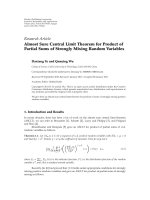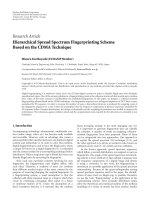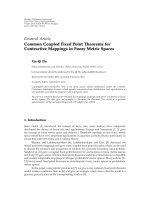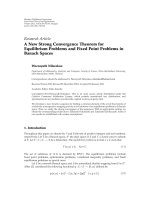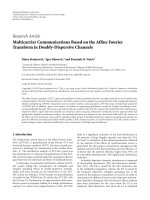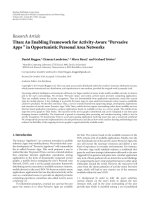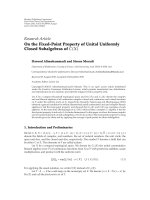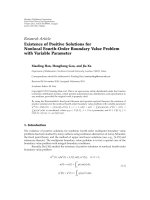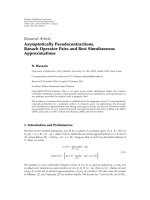báo cáo hóa học:" Research Article Browder’s Fixed Point Theorem and Some Interesting Results in Intuitionistic Fuzzy Normed Spaces" doc
Bạn đang xem bản rút gọn của tài liệu. Xem và tải ngay bản đầy đủ của tài liệu tại đây (491.36 KB, 11 trang )
Hindawi Publishing Corporation
Fixed Point Theory and Applications
Volume 2010, Article ID 642303, 11 pages
doi:10.1155/2010/642303
Research Article
Browder’s Fixed Point Theorem and
Some Interesting Results in Intuitionistic
Fuzzy Normed Spaces
M. Cancan
Department of Mathematics, Yuzuncu Yil University, 65080 Van, Turkey
Correspondence should be addressed to M. Cancan, m
Received 18 August 2010; Accepted 11 November 2010
Academic Editor: D. R. Sahu
Copyright q 2010 M. Cancan. This is an open access article distributed under the Creative
Commons Attribution License, which permits unrestricted use, distribution, and reproduction in
any medium, provided the original work is properly cited.
We define and study Browder’s fixed point theorem and relation between an intuitionistic fuzzy
convex normed space and a strong intuitionistic fuzzy uniformly convex normed space. Also,
we give an example to show that uniformly convex normed space does not imply strongly
intuitionistic fuzzy uniformly convex.
1. Introduction
In recent years, the fuzzy theory has emerged as the most active area of research in many
branches of mathematics and engineering. Fuzzy set theory is a powerful hand set for
modelling uncertainty and vagueness in various problems arising the field of science and
engineering. Now a large number of research papers appear by using the concept of fuzzy
set/numbers, and fuzzification of many classical theories has also been made. It has also
very useful applications in various fields, for example, nonlinear operator 1, stability
problem 2, 3, and so forth. The fuzzy topology 4–8 proves to be a very useful tool to
deal with such situations where the use of classical theories breaks down. One of the most
important problems in fuzzy topology is to obtain an appropriate concept of an intuitionistic
fuzzy metric space and an intuitionistic fuzzy normed space. These problems have been
investigated by Park 9 and Saadati and Park 10, respectively, and they introduced and
studied a notion of an intuitionistic fuzzy normed space. The topic of fuzzy topology has
important applications as quantum particle physics. On the other hand, these problems are
also important in modified fuzzy spaces 11–14.
There are many situations where the norm of a vector is not possible to find and the
concept of intuitionistic fuzzy norm 10 , 15–17 seems to be more suitable in such cases, that
2 Fixed Point Theory and Applications
is, we can deal with such situations by modelling the inexactness through the intuitionistic
fuzzy norm.
Schauder 18 introduced the fixed point theorem, and since then several generaliza-
tions of this concept have been investigated by various authors, namely, Kirk 19, Baillon
20, Browder 21, 22 and many others. Recently, fuzzy version of various fixed point
theorems was discussed in 18, 23–28 and also its relations were investigated in 7, 29.
Quite recently the concepts of l-intuitionistic fuzzy compact set and strongly
intuitionistic fuzzy uniformly convex normed space are studied, and Schauder fixed point
theorem in intuitionistic fuzzy normed space is proved in 30. As a consequence of Theorem
4.1 30 and Browder’s theorems 26, 27 in crisp normed linear space we have Browder’s
theorems in intuitionistic fuzzy normed space. Also we give relation between an intuitionistic
fuzzy uniformly convex normed space and a strongly intuitionistic fuzzy uniformly convex
normed space. Furthermore, we construct an example to show that intuitionistic fuzzy
uniformly convex normed space does not imply strongly intuitionistic fuzzy uniformly
convex.
Definition 1.1. A binary operation ∗ : 0, 1 × 0, 1 → 0, 1 is said to be a continuous t-norm
if it satisfies the following conditions:
a ∗ is associative and commutative; b ∗ is continuous; c a
∗ 1 a for all a ∈ 0, 1;
d a ∗ b ≤ c ∗ d whenever a ≤ c and b ≤ d for each a, b, c, d ∈ 0, 1.
Definition 1.2. A binary operation ♦ : 0, 1×0, 1 → 0, 1 is said to be a continuous t-conorm
if it satisfies the following conditions:
a
♦ is associative and commutative; b
♦ is continuous; c
a♦0 a for all a ∈
0, 1; d
a♦b ≤ c♦d whenever a ≤ c and b ≤ d for each a, b, c, d ∈ 0, 1. Using the notions of
continuous t-norm and t-conorm, Saadati and Park 10 have recently introduced the concept
of intuitionistic fuzzy normed space as follows.
Definition 1.3. The five-tuple X, μ, υ, ∗, ♦ is said to be intuitionistic fuzzy normed spaces for
short, IFNS if X is a vector space, ∗ is a continuous t-norm, ♦ is a continuous t-conorm, and
μ, υ are fuzzy sets on X × 0, ∞ satisfying the following conditions. For every x, y ∈ X and
s, t > 0, i μx, tυx, t ≤ 1, ii μx, t > 0, iii
μx, t1 if and only if x 0, iv μαx, t
μx, t/|α| for each α
/
0, v μx, t ∗ μy, s ≤ μx y, t s, vi μx, · : 0, ∞ → 0, 1 is
continuous, vii lim
t →∞
μx, t1 and lim
t → 0
μx, t0, viii υx,t < 1, ix υx, t0if
and only if x 0, x υαx, tυx, t/|α| for each α
/
0, xi υx, t♦υy, s ≥ υx y,t s,
xii υx, · : 0, ∞ → 0, 1 is continuous and xiii lim
t →∞
υx, t0 and lim
t → 0
υx, t1.
In this case μ, υ is called an intuitionistic fuzzy norm.
The concepts of convergence and Cauchy sequences in an intuitionistic fuzzy normed
space are studied in 10.
Definition 1.4. Let X, μ, υ, ∗, ♦ be an IFNS. Then, a sequence x x
k
is said to be
intuitionistic fuzzy convergent to L ∈ X if lim μx
k
− L, t1 and lim υx
k
− L, t0for
all t>0. In this case we write μ, υ − lim x
n
x or x
k
IF
−−→ L as k →∞.
Definition 1.5. Let X, μ, υ, ∗, ♦ be an IFNS. Then, x x
k
is said to be intuitionistic fuzzy
Cauchy sequence if lim μx
kp
− x
k
,t1 and lim υx
kp
− x
k
,t0 for all t>0andp
1, 2,
Fixed Point Theory and Applications 3
Definition 1.6. Let X, μ, υ, ∗, ♦ be an IFNS. Then X, μ, υ, ∗, ♦ is said to be complete if every
intuitionistic fuzzy Cauchy sequence in X, μ, υ, ∗, ♦ is intuitionistic fuzzy convergent in
X, μ, υ, ∗, ♦.
Definition 1.7 see 2.LetX, μ, υ, ∗, ♦ be an IFNS with the condition
μ
x, t
> 0,υ
x, t
< 1 implies that x 0, ∀t ∈ R. 1.1
Let x
α
inf{t>0:μx, t ≥ α and υx, t ≤ 1 − α}, for all α ∈ 0, 1. Then { ·
α
: α ∈ 0, 1}
is an ascending family of norms on X. These norms are called α-norms on X corresponding
to intuitionistic fuzzy norm μ, υ.
It is easy to see the following.
Proposition 1.8. Let X, μ, υ, ∗, ♦ be an IFNS satisfying 1.1, and let x
k
be a sequence in X.
Then lim μx
k
− x, t1 and lim υx
k
− x, t0 if and only if lim
n →∞
x
k
− x
α
0 for all
α ∈ 0, 1.
Proposition 1.9 see 25. Let X, μ, υ, ∗, ♦ be an IFNS satisfying 1.1 . Then a subset M of X
is l-intuitionistic fuzzy bounded if and only if M is bounded with respect to ·
α
, for all α ∈ 0, 1,
where ·
α
denotes the α-norm of μ, υ.
Recently, 1, 29 introduced the concept of strong and weak intuitionistic fuzzy
continuity as well as strong and weak intuitionistic fuzzy convergent.
Some notations and results which will be used in this paper 25 are given below.
i The linear space V R and C is an intuitionistic fuzzy normed space with respect
to the intuitionistic fuzzy norm μ
2
,υ
2
defined as
μ
2
x, t
⎧
⎨
⎩
1ift>
|
x
|
,
0ift ≤
|
x
|
,
υ
2
x, t
⎧
⎨
⎩
0ift>
|
x
|
,
1ift ≤
|
x
|
,
1.2
satisfying 1.1 condition and x
α
|x|, for all α ∈ 0, 1.
ii If X, μ
1
,υ
1
, ∗, ♦ is a intuitionistic fuzzy normed space, then U
∗
α
denotes the set
of all linear functions from X to Y which are bounded as linear operators from
X, ·
1
α
to Y, ·
2
α
, where ·
1
α
and ·
2
α
denote α-norms of μ
1
,υ
1
and μ
2
,υ
2
,
respectively.
iii U
∗
α
is clearly the first dual space of X, ·
1
α
for α ∈ 0, 1.
Definition 1.10. Let X, μ
1
,υ
1
, ∗, ♦ be an intuitionistic fuzzy normed space satisfying 1.1,
and let Y, μ
2
,υ
2
, ∗, ♦ be the intuitionistic fuzzy normed space defined in the above remark.
A sequence x
n
∈ X is said to be l-intuitionistic fuzzy weakly convergent and converges to
x
0
if for all α ∈ 0, 1 and for all f ∈ U
∗
α
dual space with respect to ·
α
, fx
n
→
n →∞
fx
0
,
that is
lim
n →∞
μ
2
f
x
n
− f
x
0
,t
1, lim
n →∞
υ
2
f
x
n
− f
x
0
,t
0,
1.3
for all f ∈ U
∗
α
.
4 Fixed Point Theory and Applications
Definition 1.11 see 25.LetX, μ, υ, ∗, ♦ be an IFNS. A mapping T : X, μ, υ, ∗, ♦ →
X, μ, υ, ∗, ♦ is said to be intuitionistic nonexpansive if
μ
T
x
− T
y
,t
≥ μ
x − y, t
,υ
T
x
− T
y
,t
≤ μ
x − y, t
1.4
for all x, y ∈ X, for all t ∈ R.
2. Browder’s Theorems and Some Results in IFNS
In this section, we discuss the idea of fuzzy type of some Browder’s fixed point theorems
in intuitionistic fuzzy normed space by 26, 27. As a consequence of Theorem 4.1 30 and
Browder’s theorems 26, 27 in crisp normed linear space we have Browder’s theorems in
intuitionistic fuzzy normed space.
Theorem 2.1. Let K be a nonempty l-intuitionistic fuzzy weakly compact convex subset of a
strong intuitionistic fuzzy uniformly convex normed space X, μ, υ, ∗, ♦ satisfying 1.1. Then every
intuitionistic fuzzy nonexpansive mapping T : K → K has a fixed point.
Theorem 2.2. Let X, μ, υ, ∗, ♦ be a strong intuitionistic fuzzy uniformly convex normed space
satisfying 1.1.LetK be an l-intuitionistic fuzzy bounded and l-intuitionistic fuzzy closed convex
subset of X, and let T be an intuitionistic fuzzy nonexpansive mapping of K into X. Suppose that for
x
n
∈ K, x
n
− Tx
n
→ 0 as strongly intuitionistic fuzzy convergent while x
n
− x
0
→ 0 as
l-intuitionistic fuzzy weakly convergent. Then Tx
0
x
0
.
Now, we give relation between a intuitionistic fuzzy uniformly convex normed space
and a strongly intuitionistic fuzzy uniformly convex normed space.
Proposition 2.3. If X, μ, υ, ∗, ♦ is a strong intuitionistic fuzzy uniformly convex normed space,
then it is a i ntuitionistic fuzzy uniformly convex normed space.
Proof. Recall that X, μ, υ, ∗, ♦ is said to be strong intuitionistic fuzzy uniformly convex if for
each ε ∈ 0, 2, there exists δ ∈ 0, 1 such that φ
/
D
ε
⊂F
δ
. For all x, y ∈ X, where
D
ε
x, y
: μ
x − y, ε
<μ
x, 1
∗ μ
y, 1
,υ
x − y, ε
>υ
x, 1
♦υ
y, 1
,
F
δ
x, y
: μ
x y
2
,δ
≥ μ
x, 1
∗ μ
y, 1
,υ
x y
2
,δ
≤ υ
x, 1
♦υ
y, 1
2.1
and together with
μ
x, t
lim
s → t
−
μ
x, s
,υ
x, t
lim
s → t
υ
x, s
2.2
and also X, μ, υ, ∗, ♦ is said to be intuitionistic fuzzy uniformly convex by Definition 1.7 if
for each ε ∈ 0, 2, there exists δ ∈ 0, 1 such that
k
x
,k
y
≤ 1; k
x−y
>ε
⇒ k
xy/2
≤ δ 2.3
Fixed Point Theory and Applications 5
for all x, y ∈ X, where
k
x
min
α∈
0,1
min
t>0
μ
x, t
≥ α, υ
x, t
≤ 1 − α
.
2.4
Suppose that X, μ, υ, ∗, ♦ is strong intuitionistic fuzzy uniformly convex normed space.
Choose ε ∈ 0, 2 and x, y ∈ X such that k
x
,k
y
≤ 1; k
x−y
>ε.Now,k
x
≤ 1 implies that
max
α∈
0,1
min
t>0
μ
x, t
≥ α, υ
x, t
≤ 1 − α
≤ 1
⇒ min
t>0
μ
x, t
≥ α, υ
x, t
≤ 1 − α
,
2.5
for all α ∈ 0, 1.
Case 2.4. If for some α
0
say∈ 0, 1,
min
t>0
μ
x, t
≥ α
0
,υ
x, t
≤ 1 − α
0
< 1, 2.6
then
μ
x, 1
≥ α
0
,υ
x, 1
≤ 1 − α
0
. 2.7
Case 2.5. If for some α
1
say∈ 0, 1,min
t>0
μx, t ≥ α
1
,υx, t ≤ 1−α
1
1 implies that there
exists a sequence t
n
with t
n
↓ 1, μx, t
n
≥ α
1
and with t
n
↑ 1, υx, t ≤ 1 − α
1
, for all n
⇒ lim
t
n
↓1
μ
x, t
n
≥ α
1
, lim
t
n
↑1
υ
x, t
n
≤ 1 − α
1
⇒ μ
x, 1
≥ α
1
,υ
x, 1
≤ 1 − α
1
.
2.8
For 2.7, 2.8 we get that k
x
≤ 1 implies μx, 11andυx, 11. Similarly, k
y
≤ 1 implies
μy, 11andυy, 11. Now, k
x−y
>εimplies
max
α∈
0,1
min
t>0
μ
x − y, t
≥ α, υ
x − y, t
≤ 1 − α
>ε
2.9
⇒ there exists α
2
say∈ 0, 1 such that
min
t>0
μ
x − y, t
≥ α
2
,υ
x − y, t
≤ 1 − α
2
>ε
2.10
⇒ μx − y, ε <α
2
< 1andυx − y, ε > 1 − α
2
> 0. We claim that
μ
x − y, ε
< 1,υ
x − y, ε
> 0. 2.11
6 Fixed Point Theory and Applications
If possible suppose that μx − y, ε1andυx − y, ε0 implies that there exists a sequence
ε
n
with ε
n
↓ ε such that lim
ε
n
↓ε
μx − y, ε
n
1 and with ε
n
↑ ε such that lim
ε
n
↑ε
υx − y, ε
n
0 ⇒ μx − y, ε
n
1andυx − y, ε
n
0, for all n ⇒ μx − y, ε
n
>αand υx − y, ε
n
< 1 − α,
for all n and α ∈ 0, 1 ⇒
min
t>0
μ
x − y, t
≥ α, υ
x − y, t
≤ 1 − α
≤ ε
n
,
2.12
for all n and α ∈ 0, 1 ⇒
min
t>0
μ
x − y, t
≥ α, υ
x − y, t
≤ 1 − α
≤ ε,
2.13
for all α ∈ 0, 1 ⇒
max
α∈
0,1
min
t>0
μ
x − y, t
≥ α, υ
x − y, t
≤ 1 − α
≤ ε,
2.14
⇒ k
x−y
≤ ε, a contradiction. Thus
k
x−y
>ε⇒ μ
x − y, ε
< 1,υ
x − y, ε
> 0. 2.15
Now from above we get that, k
x
,k
y
≤ 1; k
x−y
>ε implies
μ
x − y, ε
<
μ
x, 1
∗ μ
y, 1
,υ
x − y, ε
>
υ
x, 1
♦υ
y, 1
2.16
⇒
μ
x y
2
,δ
≥
μ
x, 1
∗ μ
y, 1
,υ
x y
2
,δ
≤
υ
x, 1
♦υ
y, 1
2.17
such that the idea of strong uniform convexity of X, μ, υ, ∗, ♦ ⇒
μ
x y
2
,δ
≥ 1,υ
x y
2
,δ
≤ 0 2.18
⇒
μ
x y
2
,δ
≥ 1 >α, υ
x y
2
,δ
≤ 0 < 1 − α, 2.19
for all α ∈ 0, 1 ⇒
min
t>0
μ
x y
2
,t
≥ α, υ
x y
2
,t
≤ 1 − α
≤ δ, 2.20
Fixed Point Theory and Applications 7
for all α ∈ 0, 1 ⇒
max
α∈0,1
min
t>0
μ
x y
2
,t
≥ α, υ
x y
2
,t
≤ 1 − α
≤ δ. 2.21
Now for any positive number ε
1
say we get
μ
x, t ε
1
≥ μ
x, t
,υ
x, t ε
1
≤ υ
x, t
. 2.22
Thus,
μ
x, t
≥ α, υ
x, t
≤ 1 − α 2.23
implies that
μ
x, t ε
1
≥ α, υ
x, t ε
1
≤ 1 − α, 2.24
for all α ∈ 0, 1 ⇒
min
t>0
μ
x, t
≥ α, υ
x, t
≤ 1 − α
≥ min
t>0
μ
x, t ε
1
≥ α, υ
x, t ε
1
≤ 1 − α
,
2.25
for all α ∈ 0, 1 ⇒
min
t>0
μ
x, t
≥ α, υ
x, t
≤ 1 − α
≥ min
s−ε
1
>0
μ
x, s
≥ α, υ
x, s
≤ 1 − α
2.26
for all α ∈ 0, 1 ⇒
min
t>0
μ
x, t
≥ α, υ
x, t
≤ 1 − α
≥ min
s>ε
1
μ
x, s
≥ α, υ
x, s
≤ 1 − α
− ε
1
,
2.27
for all α ∈ 0, 1 ⇒
min
t>0
μ
x, t
≥ α, υ
x, t
≤ 1 − α
≥ min
s>0
μ
x, s
≥ α, υ
x, s
≤ 1 − α
− ε
1
,
2.28
for all α ∈ 0, 1 ⇒
max
α∈
0,1
min
t>0
μ
x, t
≥ α, υ
x, t
≤ 1 − α
≥ max
α∈
0,1
min
s>0
μ
x, s
≥ α, υ
x, s
≤ 1 − α
− ε
1
,
2.29
for all α ∈ 0, 1 ⇒
max
α∈
0,1
min
t>0
μ
x, t
≥ α, υ
x, t
≤ 1 − α
≥ k
s
− ε
1
. 2.30
8 Fixed Point Theory and Applications
From 2.21, 2.30,wegetthat,k
x
,k
y
≤ 1; k
x−y
>ε implies k
xy/2
− ε
1
≤ δ, for any ε
1
>
0 ⇒ k
xy/2
− δ ≤ ε
1
, for any ε
1
> 0 ⇒ k
xy/2
− δ ≤ 0thatisk
xy/2
≤ δ. Hence, we
have k
x
,k
y
≤ 1; k
x−y
>ε ⇒ k
xy/2
≤ δ.SoX, μ, υ, ∗, ♦ is intuitionistic fuzzy uniformly
convex.
Remark 2.6. However, the reverse of this Proposition 2.3 is untrue. This fact can be seen in the
following example.
Let X R
2
R is the set of all real numbers. Suggest two norms on X as the following:
x
x
2
1
x
2
2
1/2
and x
max|x
1
|, |x
2
|, where x x
1
,x
2
. Clearly x
≥x
, for all
x ∈ X, and it can be easily verified that X is uniformly convex with regard to ·
. Define a
function μ : X × R → 0, 1 and υ : X × R → 0, 1 by
μ
x, t
⎧
⎪
⎪
⎪
⎪
⎪
⎪
⎪
⎪
⎪
⎨
⎪
⎪
⎪
⎪
⎪
⎪
⎪
⎪
⎪
⎩
1ift ≥
x
,
1
2
if
x
≤ t<
x
,
1
3
if 0 <t<
x
,
0ift ≤ 0,
υ
x, t
⎧
⎪
⎪
⎪
⎪
⎪
⎪
⎪
⎪
⎪
⎨
⎪
⎪
⎪
⎪
⎪
⎪
⎪
⎪
⎪
⎩
0ift ≥
x
,
1
3
if
x
≤ t<
x
,
1
2
if 0 <t<
x
,
1ift ≤ 0.
2.31
It can be easily verified that μ, υ is a intuitionistic fuzzy norm on X.Now,
k
x
x
,k
y
y
,k
x−y
x − y
,k
xy/2
x y
2
.
2.32
Thus X, μ, υ, ∗, ♦ is intuitionistic fuzzy uniformly convex normed space. So, since this is
not uniformly convex with regard to ·
, therefore there exists ε ∈ 0, 2 such that for all
δ ∈ 0, 1 we have x
δ
,y
δ
∈ X such that,
x
δ
≤ 1,
y
δ
≤ 1,
x
δ
− y
δ
>εbut
x y
2
>δ
. 2.33
Now, x
δ
≤ 1 ⇒ μx
δ
, 1 ≥ 1/2andυx
δ
, 1 ≤ 1/2. Reversely, μx
δ
, 1 ≥ 1/2andυx
δ
, 1 ≤
1/2 ⇒ lim
ε
n
↓1
μx
δ
,ε
n
≥ 1/2 and lim
ε
n
↑1
υx
δ
, 1 ≤ 1/2 ⇒x
δ
≤ ε
n
,forn ⇒x
δ
≤ 1.
Hence
x
δ
≤ 1 ⇐⇒ μ
x
δ
, 1
≥
1
2
,υ
x
δ
, 1
≤
1
2
. 2.34
Again,
y
δ
≤ 1 ⇐⇒ μ
y
δ
, 1
≥
1
2
,υ
y
δ
, 1
≤
1
2
. 2.35
Fixed Point Theory and Applications 9
So, x
δ
− y
δ
>ε>0 ⇒ μx
δ
− y
δ
,ε1/3 ⇒ μx
δ
− y
δ
,ε ≥ 1/3andυx
δ
− y
δ
,ε ≤ 1/3.
We suggest that μx
δ
− y
δ
,ε1/3andυx
δ
− y
δ
,ε1/3. If μx
δ
− y
δ
,ε > 1/3,υx
δ
−
y
δ
,ε < 1/3 ⇒ lim
ε
n
↓ε
μx
δ
− y
δ
,ε > 1/3, lim
ε
n
↑ε
υx
δ
− y
δ
,ε < 1/3 ⇒ μx
δ
− y
δ
,ε
n
> 1/3,
υx
δ
− y
δ
,ε
n
< 1/3, for n ⇒ μx
δ
− y
δ
,ε
n
> 1/2, υx
δ
− y
δ
,ε
n
< 1/2, for n ⇒x
δ
− y
δ
≤ ε
n
,
for n ⇒x
δ
− y
δ
≤ ε; however this is a contradiction that is
x
δ
− y
δ
>ε⇒ μ
x
δ
− y
δ
,ε
1
3
,υ
x
δ
− y
δ
,ε
1
3
. 2.36
Otherwise μx
δ
− y
δ
,ε1/3, υx
δ
− y
δ
,ε1/3 ⇒ μx
δ
− y
δ
,ε ≤ 1/3, υx
δ
− y
δ
,ε ≥ 1/3 ⇒
x
δ
− y
δ
>ε,andthus
μ
x
δ
− y
δ
,ε
1
3
,υ
x
δ
− y
δ
,ε
1
3
⇒
x
δ
− y
δ
>ε. 2.37
By 2.36 and 2.37 we get
x
δ
− y
δ
>ε⇐⇒ μ
x
δ
− y
δ
,ε
1
3
,υ
x
δ
− y
δ
,ε
1
3
. 2.38
Again
x
δ
− y
δ
2
>δ⇐⇒ μ
x
δ
y
δ
2
,δ
1
3
,υ
x
δ
y
δ
2
,δ
1
3
. 2.39
Hence with 2.35, 2.36, 2.37, 2.38,and2.39 we have
μ
x
δ
− y
δ
,ε
<
μ
x
δ
, 1
∗ μ
y
δ
, 1
,υ
x
δ
− y
δ
,ε
>
υ
x
δ
, 1
♦υ
y
δ
, 1
2.40
but
μ
x
δ
y
δ
2
,δ
<
μ
x
δ
, 1
∗ μ
y
δ
, 1
,υ
x
δ
y
δ
2
,δ
>
υ
x
δ
, 1
♦υ
y
δ
, 1
. 2.41
Moreover x
δ
,y
δ
∈D
ε
but x
δ
,y
δ
/
∈F
δ
that is D
ε
/
⊂F
δ
. However X, μ, υ, ∗, ♦ is not a
uniformly convex intuitionistic fuzzy normed space.
3. Conclusion
We studied here the concept of intuitionistic fuzzy normed space as an extension of the fuzzy
normed space, which provides a larger setting to deal with the uncertainly and vagueness in
natural problems arising in many branches of science and engineering. In this new setup we
established Browder’s fixed point theorem and some interesting results in intuitionistic fuzzy
normed space which could be very useful tools in the development of fuzzy set theory.
10 Fixed Point Theory and Applications
References
1 M. Mursaleen and S. A. Mohiuddine, “Nonlinear operators between intuitionistic fuzzy normed
spaces and Fr
´
echet derivative,” Chaos, Solitons and Fractals, vol. 42, no. 2, pp. 1010–1015, 2009.
2 S. A. Mohiuddine, “Stability of Jensen functional equation in intuitionistic fuzzy normed space,”
Chaos, Solitons and Fractals, vol. 42, no. 5, pp. 2989–2996, 2009.
3 M. Mursaleen and S. A. Mohiuddine, “On stability of a cubic functional equation in intuitionistic
fuzzy normed spaces,” Chaos, Solitons and Fractals, vol. 42, no. 5, pp. 2997–3005, 2009.
4 M. A. Erceg, “Metric spaces in fuzzy set theory,” Journal of Mathematical Analysis and Applications, vol.
69, no. 1, pp. 205–230, 1979.
5 O. Kaleva and S. Seikkala, “On fuzzy metric spaces,” Fuzzy Sets and Systems, vol. 12, no. 3, pp. 215–229,
1984.
6 A. K. Katsaras, “Fuzzy topological vector spaces. II,” Fuzzy Sets and Systems, vol. 12, no. 2, pp. 143–154,
1984.
7 R. Saadati, S. M. Vaezpour, and Y. J. Cho, “Quicksort algorithm: application of a fixed point theorem
in intuitionistic fuzzy quasi-metric spaces at a domain of words,” Journal of Computational and Applied
Mathematics, vol. 228, no. 1, pp. 219–225, 2009.
8 P. V. Subrahmanyam, “A common fixed point theorem in fuzzy metric spaces,” Information Sciences,
vol. 83, no. 3-4, pp. 109–112, 1995.
9 J. H. Park, “Intuitionistic fuzzy metric spaces,” Chaos, Solitons and Fractals, vol. 22, no. 5, pp. 1039–1046,
2004.
10 R. Saadati and J. H. Park, “On the intuitionistic fuzzy topological spaces,” Chaos, Solitons and Fractals,
vol. 27, no. 2, pp. 331–344, 2006.
11 M. Goudarzi, S. M. Vaezpour, and R. Saadati, “On the intuitionistic fuzzy inner product spaces,”
Chaos, Solitons and Fractals, vol. 41, no. 3, pp. 1105–1112, 2009.
12 S. Jain, S. Jain, and L. Bahadur Jain, “Compatibility of type P in modified intuitionistic fuzzy metric
space,” Journal of Nonlinear Science and Its Applications, vol. 3, no. 2, pp. 96–109, 2010.
13 R. Saadati, S. Sedghi, and N. Shobe, “Modified intuitionistic fuzzy metric spaces and some fixed point
theorems,” Chaos, Solitons and Fractals, vol. 38, no. 1, pp. 36–47, 2008.
14 S. Shakeri, “Intuitionistic fuzzy stability of Jensen type mapping,” Journal of Nonlinear S cience and Its
Applications, vol. 2, no. 2, pp. 105–112, 2009.
15 S. A. Mohiuddine and Q. M. D. Lohani, “On generalized statistical convergence in intuitionistic fuzzy
normed space,” Chaos, Solitons and Fractals, vol. 42, no. 3, pp. 1731–1737, 2009.
16 M. Mursaleen and S. A. Mohiuddine, “Statistical convergence of double sequences in intuitionistic
fuzzy normed spaces,” Chaos, Solitons and Fractals, vol. 41, no. 5, pp. 2414–2421, 2009.
17 M. Mursaleen and S. A. Mohiuddine, “On lacunary statistical convergence with respect to the
intuitionistic fuzzy normed space,” Journal of Computational and Applied Mathematics, vol. 233, no. 2,
pp. 142–149, 2009.
18 J. Schauder, “Der Fixpunktsatz in Funktionalraumen,” Studia Mathematica, vol. 2, pp. 171–180, 1930.
19 W. A. Kirk, “A fixed point theorem for mappings which do not increase distances,” The American
Mathematical Monthly, vol. 72, pp. 1004–1006, 1965.
20 J B. Baillon and R. Sch
¨
oneberg, “Asymptotic normal structure and fixed points of nonexpansive
mappings,” Proceedings of the American Mathematical Society, vol. 81, no. 2, pp. 257–264, 1981.
21 F. E. Browder, “Nonexpansive nonlinear operators in a Banach space,” Proceedings of the National
Academy of Sciences of the United States of America, vol. 54, pp. 1041–1044, 1965.
22 F. E. Browder, “Semicontractive and semiaccretive nonlinear mappings in Banach spaces,” Bulletin of
the American Mathematical Society, vol. 74, pp. 660–665, 1968.
23 T. Bag and S. K. Samanta, “Finite dimensional fuzzy normed linear spaces,” Journal of Fuzzy
Mathematics, vol. 11, no. 3, pp. 687–705, 2003.
24 T. Bag and S. K. Samanta, “Fuzzy bounded linear operators,” Fuzzy Sets and Systems, vol. 151, no. 3,
pp. 513–547, 2005.
25 T. Bag and S. K. Samanta, “Some fixed point theorems in fuzzy normed linear spaces,” Information
Sciences, vol. 177, no. 16, pp. 3271–3289, 2007.
26 A. Chitra and P. V. Subrahmanyam, “Fuzzy sets and fixed points,” Journal of Mathematical Analysis and
Applications, vol. 124, no. 2, pp. 584–590, 1987.
27 V. Gregori and S. Romaguera, “Fixed point theorems for fuzzy mappings in quasi-metric spaces,”
Fuzzy Sets and Systems, vol. 115, no. 3, pp. 477–483, 2000.
28 S. Heilpern, “Fuzzy mappings and fixed point theorem,” Journal of Mathematical Analysis and
Applications, vol. 83, no. 2, pp. 566–569, 1981.
Fixed Point Theory and Applications 11
29 S. A. Mohiuddine, H. S¸evli, and M. Cancan, “Statistical convergence in fuzzy 2-normed space,” Journal
of Computational Analysis and Applications, vol. 12, no. 4, pp. 787–798, 2010.
30 S. A. Mohiuddine, M. Cancan, and H. Sevli, “Schauder fixed point theorem and some related concepts
in intuitionistic fuzzy normed spaces,” submitted.
